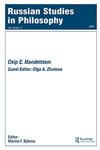Translation as the Manufacturing of Meaning: A Few Words about the Title of Ibn Khaldūn’s History
IF 0.1
4区 哲学
Q4 Arts and Humanities
引用次数: 0
Abstract
ABSTRACT Meaning is not a ready-made entity found in dictionaries as signified by a language sign, but rather something which is manufactured through a sense-positing procedure that starts with an initial intuition and runs until the text is written down. This initial intuition may have two interpretations, namely, a substance-based and a process-based readings. This option sets down a bifurcation point on a way towards the text’s final meaning. The translator’s task is, firstly, to understand which of the two possible routes, running from this bifurcation point, the author of the text opted for and, secondly, to accomplish the translation (i.e., to manufacture its meaning) accordingly. The cognitive models adopted by Arabic and Islamic authors serve as markers to highlight the author’s choice. The ẓāhir-bāṭin (“manifest-hidden”) opposition is one of such models which, provided it is correctly interpreted by the translator, enables him/her to adequately reproduce the meaning of the text. This article examines the opening pages of the English, French, and Russian translations of the “Introduction” to Ibn Khaldūn’s “History” which includes its title. It shows how the translators passed the initial bifurcation point and how their option affected the final meaning of their translations.翻译是意义的制造——关于伊本·哈立德《历史》书名的几句话
摘要意义不是字典中现成的由语言符号表示的实体,而是通过一个从最初的直觉开始并一直持续到文本被写下来的感觉定位过程制造出来的。这种最初的直觉可能有两种解释,即基于物质的阅读和基于过程的阅读。这个选项在通往文本最终含义的道路上设置了一个分叉点。译者的任务是,首先,了解从这个分歧点出发,文本作者选择了两条可能的路线中的哪一条,其次,相应地完成翻译(即制造其含义)。阿拉伯和伊斯兰作家采用的认知模式是突出作者选择的标志。这个ẓāhir-bāṭ在(“显性-隐性”)对立是这样一种模式,只要译者正确地解释它,就能使他/她充分地再现文本的含义。本文考察了伊本·哈立德的《历史》的英文、法文和俄文译本的首页,其中包括书名。它展示了译者如何通过最初的分歧点,以及他们的选择如何影响他们翻译的最终含义。
本文章由计算机程序翻译,如有差异,请以英文原文为准。
求助全文
约1分钟内获得全文
求助全文
来源期刊

RUSSIAN STUDIES IN PHILOSOPHY
PHILOSOPHY-
CiteScore
0.10
自引率
0.00%
发文量
14
期刊介绍:
Russian Studies in Philosophy publishes thematic issues featuring selected scholarly papers from conferences and joint research projects as well as from the leading Russian-language journals in philosophy. Thematic coverage ranges over significant theoretical topics as well as topics in the history of philosophy, both European and Russian, including issues focused on institutions, schools, and figures such as Bakhtin, Fedorov, Leontev, Losev, Rozanov, Solovev, and Zinovev.
 求助内容:
求助内容: 应助结果提醒方式:
应助结果提醒方式:


